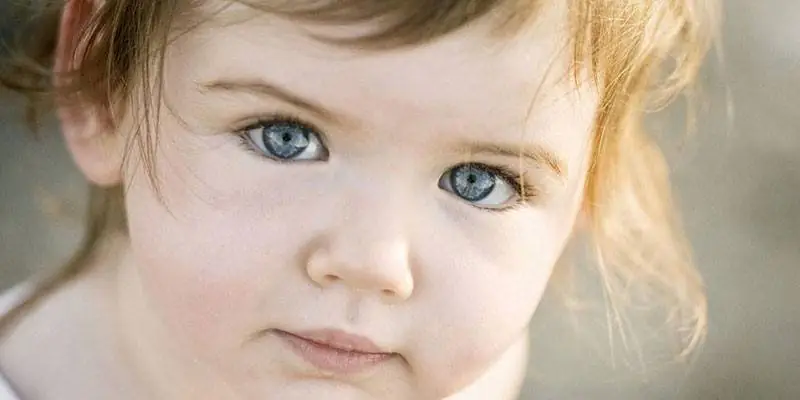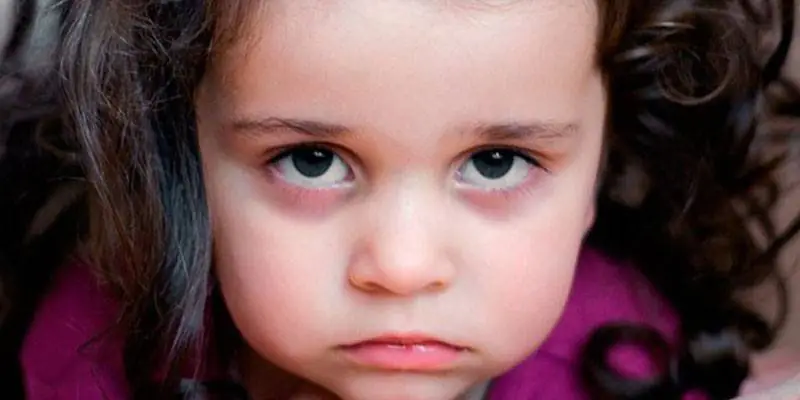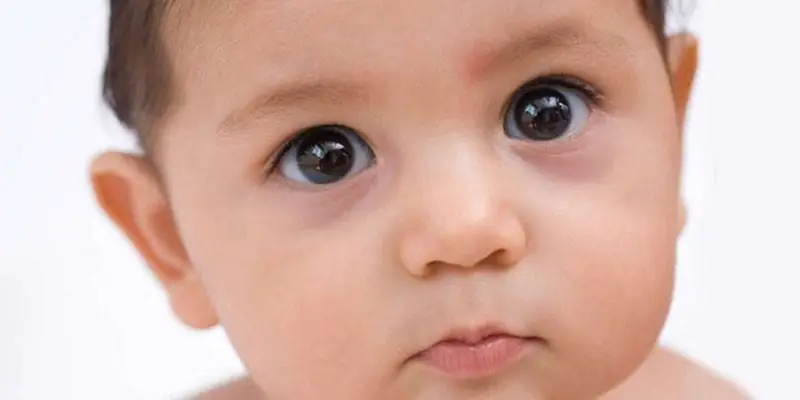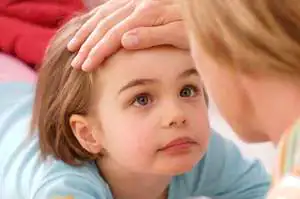The reasons for the appearance of bruises under the eyes in children of different ages can be harmless and easily eliminated. But in some cases, dark circles under the eyes are symptoms of serious systemic failures in the body. If your child eats well, gets enough sleep and spends a lot of time outdoors, and the skin under his eyes remains dark, you need to make an appointment with your doctor to identify the factors that provoke this phenomenon.
Causes of bruises under the eyes in children
A number of factors can contribute to the appearance of circles or swollen bruises around the eyes of a child. Disturbed daily routine, lack of sleep and a large amount of time spent at the computer or in front of the TV, poor unbalanced diet and impaired drinking regime are easily correctable causes, the elimination of which not only leads to the disappearance of bruises around the eyes, but also helps to improve the general state of his health. . In some cases, a change in skin color indicates the following pathological disorders:
- helminthiasis (parasitic infection);
- iron deficiency anemia (insufficient levels of iron in the blood);
- kidney disease;
- endocrine diseases;
- diabetes;
- weakening of the immune system.
Sometimes blue circles around the eyes are an appearance trait, a hereditary trait through one of the parents. It is typical for people with fair hair, deep-set eyes, and sensitive, thin skin from birth. Blood vessels that come close to the surface of the skin can also create a bruising effect. These cases should not cause concern; over time, the color of the skin around the eyes may normalize as facial features change due to the growth of the cranial bones.

Often the child is pale and has bruises under the eyes due to excessive fatigue and a disrupted daily routine. Overwork and chronic lack of sleep occur against the background of increased mental or physical stress, when going to bed and waking up in the morning occur at different times, daytime sleep is not regulated, and time for watching cartoons and computer games is not limited. Normalizing the baby’s sleep, work and rest schedule is the first point that parents should pay attention to if they discover blueness in the child’s lower eyelids.
Bruises under the eyes of a teenager or a child of preschool or primary school age can indicate not only increased fatigue, but also metabolic disorders due to an unbalanced diet. Darkening of the skin is caused by low-quality foods, unhealthy dishes with a large number of preservatives, additives (including fast food), calcium deficiency, vitamins B, A, D, E. A blood test helps to identify such malfunctions, after which you need to consult with a specialist to develop a balanced diet, including:
- full breakfasts, lunches and dinners;
- more vitamin-rich vegetables and fruits;
- Having healthy snacks between main meals.
Violation of the water-salt balance can also cause bruises. The lack of fluid in the body is easily eliminated when the child drinks more plain water. The minimum is calculated using the formula “weight * 30”, for example, for a child weighing 25 kg, the minimum amount of liquid drunk per day is 750 ml. It is advisable to completely exclude carbonated sweet drinks, give preference to plain clean water, natural compotes and fruit drinks, and weak tea.
Bruises and bags under the eyes of a child can be a symptom of iron deficiency anemia, especially in infancy (up to a year). A lack of hemoglobin can cause a purple tint to the skin around the eyes, pale skin, weakness and dizziness, and tachycardia. Iron deficiency can be determined using a blood test; a special diet (enhanced nutrition) is recommended as treatment.
Pathological processes due to circulatory disorders, malfunctions of the lymphatic and urinary systems can cause blueness in the child’s eyes. The first organ examined is the kidneys - ultrasound, general urine and blood tests are prescribed. Additional signs of kidney disease are morning swelling of the face, the formation of “bags” (edema), pain in the lumbar region, and frequent urination. If this set of symptoms appears, you can consult a nephrologist.

Bruises under the eyes of a child may be evidence of a parasitic infection, a consequence of the release of toxic waste products by helminths, their entry into the baby’s blood and the development of general systemic intoxication. In this case, additional symptoms are anemia (low hemoglobin level), changes in appetite (increased or absent), weight loss, headaches, itching in the perineal area. If you suspect helminthiasis, you must take blood and stool tests and consult a doctor to select a parasite removal regimen.
In addition to kidney disease, bruising can be caused by hormonal disorders and diseases of the endocrine system. Disorders of the functions of the thyroid gland, adrenal glands and pancreas provoke disruptions in the production and transport of hormones to the tissues and cells of the body, and changes in their metabolism. If other symptoms (neurological, metabolic or somatic) appear, you need to show the child to an endocrinologist.
Color of dark circles under the eyes
Depending on the skin color of the bruises under the eyes, experts make assumptions about the nature of the disorder and the location of the pathology in the body. The following clinical cases are probable:
- Deep blue skin color may be a symptom of heart problems. It occurs due to oxygen starvation, which develops due to vascular disorders.
- Red, blue-pink and blue shades indicate an allergic reaction.
- Purple bags under the eyes are a symptom of anemia.
- Brown and yellow-brown bruises occur with hepatitis, liver and thyroid diseases.
The cause of dark bruises can be a weakened immune system, especially after antibacterial therapy (due to disruption of the intestinal microflora), taking immunosuppressants, or undergoing surgery. In such situations, the symptom goes away after a rehabilitation period and complex immunoregenerative therapy.
Bruises under the eyes of a baby
In the first year of life, bruises in the eye area of a child may appear against the background of a deficiency of vitamins or iron in the body (for example, with defective breast milk), due to disrupted wakefulness and sleep patterns, against the background of the development of serious systemic disorders and pathologies. It is imperative to undergo a comprehensive examination, identify the causes causing the symptom, and obtain recommendations on nutrition and daily routine from a pediatrician.

When immediate medical attention is needed
In extreme cases, which do not happen very often, an acute condition may occur, accompanied by the appearance of dark bruises on the lower eyelids. Emergency medical assistance should be called in the following situations:
- The appearance of bruises is accompanied by breathing problems, severe weakness, and the child’s facial features become sharper. Such symptoms are typical for acute cardiovascular problems; the child may require emergency hospitalization.
- Bruising is preceded by prolonged diarrhea or severe prolonged vomiting. Circles around the eyes in these situations indicate the onset of acute dehydration (dehydration), which is very dangerous for the health of young children.

When dark circles under the eyes of a child appear, parents begin to worry, why did this happen? The kid cannot explain to them what is bothering him. If the child follows a daily routine and eats well, then the cause is a disease and you need to seek help from a pediatrician. A teenager just needs to change his daily routine, get enough sleep and give his body more time to rest. But in older children there are many reasons for the appearance of blueness under the eyes.
Causes of bruises under the eyes in children
Main reasons the appearance of circles under the eyes of a child:
- Anemia. A common reason is when a child’s body lacks vitamins and iron, the baby’s appearance deteriorates. The face becomes pale, and the blood vessels are clearly visible through the thin layers of the skin. When there is insufficiency of iron in the body, the epidermis begins to dry out and the skin defect becomes more pronounced. The circles under the eyes become dark purple, almost black.
- Allergy. It occurs on pets, plant pollen and food; reddish spots appear under the eyes, in the nasolabial folds, on the cheeks and wings of the nose. Contact your doctor and he will prescribe treatment for you.
- Helminthiasis. In preschool age and younger schoolchildren, there is a problem with worms. Worm infestation is accompanied by symptoms: bruises under the child’s eyes turn brownish, pain in the navel, teeth grinding at night, weight loss with increased or decreased appetite. The child has bruises under the eyes, has restless sleep, and becomes moody, lethargic, or overexcited.
- Genetic factor. Why do children have bruises under their eyes? The blue color under the eyes can be noticeable from birth, the reason for this is thin skin, through which the capillaries are clearly visible. The blood vessels in some newborns are located close to the top layer of skin. The genes are not corrected and this phenomenon will remain in the child. You will need to contact a dermatologist so that he can prescribe a special composition for the care of delicate skin.
- Vegetovascular dystonia. Causes the appearance of circles under the eyes and is accompanied by symptoms: headaches, dizziness, pale skin, intolerance to stuffiness, weakness and fatigue.
- Sedentary lifestyle. This problem occurs mainly among schoolchildren. He spends a lot of time at school, then does homework and sits at the computer in his free time. There is no time left for walking and he receives less oxygen, the skin begins to thin and turn pale. After some time, bruises begin to appear under the eyes, the child looks tired, and begins to develop apathy and lethargy.

Overwork. This happens after the summer holidays for schoolchildren; blue circles appear under their eyes. For students, the beginning of the school year is stressful, and this does not depend on the child’s age and class; an adaptation period is still needed. Organize the correct daily routine, especially for a weak child; in addition to studying and extracurricular activities, he should have enough time for rest and entertainment.- Kidney problems. The disease is accompanied by the following symptoms: bruises appear under the child’s eyes, pain in the lumbar region, and often the need to go to the toilet. In the morning, there is swelling of the eyelids, and the urine sometimes becomes cloudy. With such problems, you need to contact a nephrologist; after an examination, he will prescribe medication and a special diet.
- Injuries to the eyes, nose, head. During active games, children fall from horizontal bars, slides, and bicycles. Schoolchildren can get hit on the head with a ball while playing football; problems are not immediately identified if there are no wounds or blood loss. There may be bruising under the eyes, swelling, or a visible mark from the blow under one eye. You will need to visit a pediatric neurologist or traumatologist to rule out a concussion or a fracture of the nasal bones.
- Chronic tonsillitis and immunodeficiency. Associated symptoms: yellow or white coating on the tongue, pain when swallowing, lump in the throat, frequent exacerbations of diseases, possible fever. It may occur after a recent infectious disease that weakens the immune system.
If a child suddenly becomes ill, he becomes pale, he develops chest pain, bruises have formed under the eyes and he has become weak, immediately call an ambulance. These symptoms occur with heart problems.
One of the reasons for negative symptoms is the appearance of dark circles under the eyes of a newborn. You need to contact your pediatrician for an examination. In the first weeks of life, such symptoms may occur due to weak immunity or imperfections of the digestive and urinary system. To prevent bruises under your baby’s eyes, you need to take preventive measures:

A nursing mother should monitor her diet; it is necessary to exclude foods that cause allergic reactions, stress on the kidneys and liver, and bloating. Stomach or intestinal problems and anemia reduce the quality of milk.- You need to feed your baby on demand, gradually switching to feeding after three hours. When the baby gets used to the regime, there will be no health problems.
- The baby should have favorable conditions for sleep. For normal rest you need: humidity, access to fresh air and optimal temperature.
- If your child wants to sleep earlier than expected, there is no need to disturb him. In the first month, the baby sleeps for up to 20 hours throughout the day. Lack of sleep will have a negative impact on the child's body.
- It is better for the child to sleep in the fresh air; in good weather, you need to walk with him more, then circles under the eyes of the baby will not appear.
Your doctor will help you identify the cause. will prescribe a examination for the baby. You will need to take urine and blood tests, undergo an ultrasound examination if necessary, and get advice from the following specialists:
- Neuropathologist — will help in organizing a gentle regimen, prescribe sedatives and painkillers.
- Nephrologist - will check your kidney function and prescribe an additional urine test and ultrasound examination.
- Cardiologist — will check your blood pressure and order an electrocardiogram. According to these data, it will confirm or deny the presence of congenital heart disease and vegetative-vascular dystonia.
Treatment methods

Fight against worms. Why does my child have bruises under his eyes? If a child has parasites in the intestines, it is necessary to carry out antihelminthic therapy and change his diet. Pharmacies sell effective anti-worm medications: Albendazole, Dekaris, Medamin, Mintezol. Together with them you need to take vitamins and sorbents: Enterosgel and activated carbon. As well as drugs to normalize the intestinal microflora “Bifidumbacterin”, “Linex”.- Daytime nap. After lunch, a preschooler needs to organize a nap hour, because the growing body cannot withstand the stress.
- Maintain the intake of vitamins and iron into the body. The child is growing rapidly and his body needs constant replenishment of iron. If this does not happen, he begins to develop anemia. With a lack of vitamins, the condition of the immune system worsens. Include raisins, dried apricots, black currants, leafy greens and rosehip decoction in your child’s diet. To prevent anemia from developing, the child needs to eat more rye bread, bran, chicken yolks, buckwheat and liver. Fresh vegetables and fruits, fermented milk products, vegetable soups and boiled beef are very healthy.
- Lotions for bruises. Why do children have bruises under their eyes? To remove dark circles under the eyes and puffiness of the eyelids, apply a lotion of green tea or chamomile infusion.
- Walks should be every day, at least two hours. A sufficient amount of oxygen will enter the body, the operation of all systems will be normalized and will provide energy to the growing body.
- Eliminate congestion. After school, the child must first rest; he must attend no more than two sections or clubs up to five days a week.

The reasons for the appearance of bruises under the eyes are different, and if dark circles accompanied by various symptoms, contact specialists for help. In the initial stages, it is easier and faster to cure the disease than to treat advanced pathology. Try to teach children to alternate stress (physical and mental) with rest. If you follow all the recommendations, your child will be healthy and vigorous.
One of the common reasons for visiting a pediatrician is the presence of “shadows” or bruises under the eyes of a baby. But why do bruises appear under a child’s eyes? What is the mechanism of their formation? Are their causes always harmless? How can you diagnose diseases that became the basis for their appearance? What diseases need to be differentiated from them? Is it possible to take preventive measures to prevent them and how can you get rid of them? These questions concern many parents.
The mechanism of development of bruises under the eyes in children
In most cases, they are formed due to thinning of the skin in this area, resulting in the blood vessels being visible. Less commonly, they are caused by hemorrhages.
Harmless causes, or Bruises in healthy children
Factors contributing to their development can be divided into several groups:
- harmless (genetic predisposition, heredity, fatigue);
- diseases with shadows under the eyes (anemia, impaired functioning of the kidneys, liver, etc.);
- emergency conditions.
The baby inherits from its parents not only sexual characteristics and appearance, but also individual structural features of the skin. So, if mom or dad have blood vessels located close to the surface of the skin, then, most likely, the baby will inherit this feature.
Carrying out special therapeutic manipulations in such cases is not required, since the cause of their occurrence is genetics, and you can’t really argue with it. Such children need to maintain a sleep-wake schedule, proper nutrition, exercise, and the prescription of general health-improving medications (vitamins, etc.).
Bruises under a child’s eyes can also appear due to fatigue.
In the modern world, parents try to keep their children occupied and interested as much as possible. Numerous sections, stress at school, disruption of sleep and rest patterns, prolonged viewing of TV and computer, and a bunch of other factors contribute to their development. This occurs because the skin becomes thinner and the vascular network begins to show through, which looks like shadows under the eyes.
For such children it is recommended:
- normalize sleep and wakefulness;
- take long walks in the fresh air;
- Let your baby watch TV and computers less;
- If the child is very busy, parents should reduce the number of sections attended.
A child may also develop bruises under his eyes for this reason.
Today you rarely meet parents who can say with confidence that their baby is eating properly, because they themselves eat junk food. The shelves of stores and supermarkets are filled with beautiful packaging or delicious products, stuffed with various chemicals, flavor enhancers and dyes. And sometimes it’s easier for parents to at least give the baby something to eat, so that he doesn’t go hungry.
Diseases with dark circles under the eyes
The reasons for their development are not always so harmless. Sometimes they can hide serious illnesses that can threaten the life and health of your baby.
Parents often have to deal with this pathology, especially those children who belong to the category of “little children.” Since a lack of hemoglobin can manifest itself in the form of dark circles under the eyes. These changes occur due to changes in the structure of the skin.
It poses a particular danger in infancy, as it can contribute to developmental delays. To identify these changes, a general blood test is taken repeatedly in children under one year of age. But in cases where the baby has bruises under the eyes, and there are no changes in the blood test, it is recommended to donate blood again after one to two months, since the body is able to replenish the lack of iron from its reserves.
Associated symptoms of this pathology may be weakness, headache, fatigue, fainting, loss of appetite, and dizziness.
If necessary, the doctor may prescribe iron supplements and include foods high in iron in the diet. These include: buckwheat, liver, apples, pomegranates, etc.
Dysfunction in the urinary system and kidney disease (for example, chronic renal failure) also contribute to the development of periorbital shadows. In most cases, their occurrence occurs in the morning. At the same time, the skin of the face becomes more edematous or “puffy.” If pathology is not detected in a timely manner or complications occur, the color of urine may change, blood pressure may increase, and dysuria may occur.
An allergic reaction in a baby to any allergen can also contribute to the appearance of shadows in this area of the face. In this case, it is necessary to first eliminate this factor and prescribe antihistamines to the child.
Pathology of the cardiovascular system can also cause these changes. They arise because the disrupted functioning of the endocardium and myocardium contributes to blood retention in the blood vessels, and since the skin in this area of the face is thin, they look like shadows. They often appear in the evening and are absent in the morning.
Parasites in babies can provoke the appearance of periorbital shadows. This is due to the fact that they contribute to poor absorption of vitamins and nutrients in the child’s body, and in addition, helminths secrete toxins (their waste products). Additional symptoms in this case will be pain in the umbilical area, bloating, increased or decreased appetite, and weakness.
Often the cause of this pathology in children is adenoids (proliferation of lymphoid tissue in the nasopharynx). As a result of these changes, the nasal passages are blocked and it is difficult for the baby to breathe. This factor contributes to brain hypoxia, thinning of the skin around the eyes and the appearance of shadows in the periorbital area.
Periorbital shadows are a consequence of intoxication manifestations or fatty damage to this organ.
Emergency conditions
This sign is very important when diagnosing emergency conditions. Shadows in the periorbital area can occur due to head injuries, intoxication, etc.
In most cases, the cause of their appearance is a fracture of the nasal bone or a bruise in this area of the face. The reason for their occurrence is hemorrhage in this area.
It can be: medication, food, alcohol, nicotine or household (by ingesting chemicals, inhaling glue, varnish, paints).
Diagnostics and differential diagnostics
A diagnosis is made after identifying the cause that contributes to their appearance and conducting an examination.
Diagnosis is carried out using:
- general blood test;
- general urinalysis;
- examination of stool for worm eggs and scrapings for enterobiasis;
- biochemical blood test;
- ultrasound examination (ultrasound) of the abdominal organs, heart, urinary system (if necessary);
- chest x-ray (if indicated);
- consultations with a nephrologist, cardiologist, gastroenterologist, hematologist, otorhinolaryngologist (if necessary).
| Eye shadow color | Pathologies that most often occur |
| Blue, accompanied by swelling | Diseases of the kidneys and urinary tract. In the absence of swelling, it occurs with: fatigue, disruption of sleep and wakefulness, hypoxia, malnutrition. |
| Purple or red-brown | Diseases of the heart and blood vessels. |
| Yellow or yellow-orange | Pathologies of the liver and biliary system. |
| Bluish | With close proximity of vessels in the periorbital region. |
| Black | In case of intoxication, dehydration, anemia. |
Elimination of bruises under the eyes in children
In order to eliminate them, it is important to know why they occurred. After this, first of all, etiological therapy (that is, affecting the cause) is prescribed.
Preventive measures include prescribing:
- normalization of sleep and wakefulness;
- walks in the fresh air;
- proper nutrition;
- timely completion of medical examinations;
- playing sports or physical education;
- complex of vitamins and microelements in the autumn-spring period.
Conclusion
There are a huge number of reasons that contribute to the development of shadows under the eyes of a baby; they can be both physiological and pathological. Therefore, it is important to consult a doctor in a timely manner, and he will determine the etiology of their appearance and prescribe the necessary therapy.
Walk with your children more often, eat right, don’t follow your kids’ lead and don’t buy them prohibited foods, don’t skip preventive examinations, allow your little ones less exposure to TV screens, computers, phones and tablets, and then there is a high probability that this the illness will pass you by.



